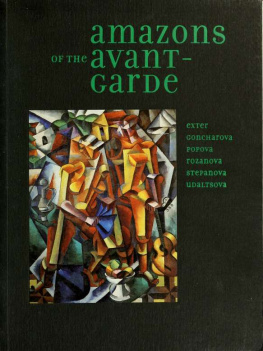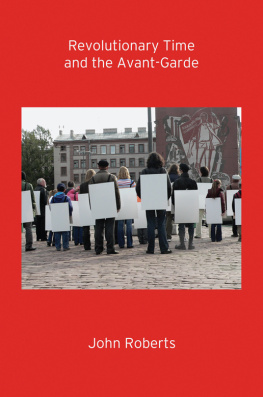Innes - Avant garde theatre, 1892-1992
Here you can read online Innes - Avant garde theatre, 1892-1992 full text of the book (entire story) in english for free. Download pdf and epub, get meaning, cover and reviews about this ebook. City: London, New York, year: 1993, publisher: Routledge, genre: Religion. Description of the work, (preface) as well as reviews are available. Best literature library LitArk.com created for fans of good reading and offers a wide selection of genres:
Romance novel
Science fiction
Adventure
Detective
Science
History
Home and family
Prose
Art
Politics
Computer
Non-fiction
Religion
Business
Children
Humor
Choose a favorite category and find really read worthwhile books. Enjoy immersion in the world of imagination, feel the emotions of the characters or learn something new for yourself, make an fascinating discovery.
- Book:Avant garde theatre, 1892-1992
- Author:
- Publisher:Routledge
- Genre:
- Year:1993
- City:London, New York
- Rating:4 / 5
- Favourites:Add to favourites
- Your mark:
- 80
- 1
- 2
- 3
- 4
- 5
Avant garde theatre, 1892-1992: summary, description and annotation
We offer to read an annotation, description, summary or preface (depends on what the author of the book "Avant garde theatre, 1892-1992" wrote himself). If you haven't found the necessary information about the book — write in the comments, we will try to find it.
Innes: author's other books
Who wrote Avant garde theatre, 1892-1992? Find out the surname, the name of the author of the book and a list of all author's works by series.
Avant garde theatre, 1892-1992 — read online for free the complete book (whole text) full work
Below is the text of the book, divided by pages. System saving the place of the last page read, allows you to conveniently read the book "Avant garde theatre, 1892-1992" online for free, without having to search again every time where you left off. Put a bookmark, and you can go to the page where you finished reading at any time.
Font size:
Interval:
Bookmark:

Examining the development of avant garde theatre from its inception in the 1890s right up to the present day, Christopher Innes exposes a central paradox of modern theatre; that the motivating force of theatrical experimentation is primitivism. What links the works of Strindberg, Artaud, Brook and Mnouchkine is an idealisation of the elemental and a desire to find ritual in archaic traditions. This widespread primitivism is the key to understanding both the political and aesthetic aspects of modern theatre and provides fresh insights into contemporary social trends.
The original text, first published in 1981 as Holy Theatre, has been fully revised and up-dated to take account of the most recent theoretical developments in anthropology, critical theory and psychotherapy. New sections on Heiner Mller, Robert Wilson, Eugenio Barba, Ariane Mnouchkine and Sam Shepard have been added. As a result, the book now deals with all the major avant garde theatre practitioners, in Europe and North America. Essential reading for anyone attempting to understand contemporary drama.
Christopher Innes is Professor of English at York University, Ontario.
First published 1993
by Routledge
11 New Fetter Lane, London EC4P 4EE
This edition published in the Taylor & Francis e-Library, 2005.
To purchase your own copy of this or any of Taylor & Francis or Routledges collection of thousands of eBooks please go to www.eBookstore.tandf.co.uk.
Simultaneously published in the USA and Canada
by Routledge Inc.
29 West 35th Street, New York, NY 10001
1993 Christopher Innes
All rights reserved. No part of this book may be reprinted or reproduced or utilized in any form or by any electronic, mechanical, or other means, now known or hereafter invented, including photocopying and recording, or in any information storage or retrieval system, without permission in writing from the publishers.
A catalogue record for this book is available from the British Library
Library of Congress Cataloging in Publication Data
Innes, C. D.
Avant garde theatre/Christopher Innes.
p. cm.
Rev. and updated ed. of: Holy theatre. 1981.
Includes bibliographical references and index.
1. Drama20th centuryHistory and criticism.
2. Experimental theater.
I. Innes, C. D. Holy theatre. II. Title.
PN1861.15 1993 9216204
809.204dc20
ISBN 0-203-35937-2 Master e-book ISBN
ISBN 0-203-37193-3 (Adobe eReader Format)
ISBN 0-415-06517-8 ISBN 0-415-06518-6 (pbk)
I should like to thank the following individuals and institutions for providing illustrative material and for permission to reproduce the various sketches and photographs: Akademie der Knste (West Berlin), Chris J. Arthurs, Agence de Presse Photographique Bernand, Zo Dominic, Ed Ellis and The Banff Centre for the Arts, Adolf u. Luisa Haeuser-Stiftung, Stadt u. Universitts Bibliothek Frankfurt am Main, Ted Hughes, Lindsay Kemp, Lipnitzki Viollet, Theatermuseum des Institutes fr Theaterwissenschaft der Universitt Kln, Museum of the Performing Arts, New York Public Library at Lincoln Center, Theatre Museum Collection Victoria and Albert Museum, Max Waldman, and Richard Feldman.
I wish to express my deep appreciation to those who helped me to define the avant garde line of development by responding to my questions and providing information so generously: in particular Roger Blin, Joe Chaikin, Lindsay Kemp, Charles Marowitz and Richard Schechner; members of Jean-Louis Barraults company at the Gare dOrsay and of the Thtre du Soleil, as well as staff at the National Theatre and Arthur Holmberg of ART. In addition I would like to thank Edward Bond for persuading me that, despite similarities in a play like Early Morning, his work had no place in this study, and Ann Saddlemyer for her helpful criticism of the first version of this study.
My thanks are also due to York University for the research fellowship that allowed me to complete the 1981 editionoriginally published by Cambridge University Press under the title of Holy Theatre. This completely revised and updated version has been supported both by a grant from the Faculty of Arts at York University, and by the Social Sciences and Humanities Research Council of Canada, to whom I am most grateful. I would also like to acknowledge the help of Marion Jaeckel and Alyson McMackon, who provided bibliographical assistance.
Last, but by no means least, my wifes unflagging interest and encouragement has been invaluable, both then and now.
Avant garde has become a ubiquitous label, eclectically applied to any type of art that is anti-traditional in form. At its simplest, the term is sometimes taken to describe what is new at any given time: the leading edge of artistic experiment, which is continually outdated by the next step forward. Butavant garde is by no means value-neutral, as such usage implies. For Marxist critics like George Lukcs it became synonymous with decadence, a cultural symptom of the malaise engendered by bourgeois society; for apologists it is the defining imperative in all art of our time, andthe modern genius is essentially avant-gardistic.
Borrowed from military terminology by Bakunin, who titled the short-lived anarchist journal he published in Switzerland in 1878 LAvant-Garde, the label was first applied to art by his followers. Their aim in revolutionizing aesthetics was to prefigure social revolution; and avant garde art is still characterized by a radical political posture. Envisioning a revolutionary future, it has been equally hostile to artistic tradition, sometimes including its immediate predecessors, as to contemporary civilization. Indeed, on the surface the avant garde as a whole seems united primarily in terms of what they are against: the rejection of social institutions and established artistic conventions, or antagonism towards the public (as representative of the existing order). By contrast any positive programme tends to be claimed as exclusive property by isolated and even mutually antagonistic sub- groups. So modern art appears fragmented and sectarian, defined as much by manifestos as imaginative work, and representing the amorphous complexity of post-industrial society in a multiplicity of dynamic but unstable movements focused on philosophic abstractions. Hence the use of-isms to describe them: symbolism, futurism, expressionism, formalism, surrealism.
However, beneath this diversity there is a clearly identifiable unity of purpose and interest (at least in the theatre) which has all the characteristics of a coherent trend, since its principles can be shown to be shared quite independent of direct influence. For example, there are striking similarities between the work of Antonin Artaud in the 1930s and of Jerzy Grotowski in the 1960s, even though Grotowski knew nothing of thetheatre of cruelty when he developed his concept ofpoor theatre. At the same time one can trace all the network of cross-fertilization that normally defines a single artistic movement, signalled equally by the continuing influence of a precursor (Alfred Jarry, August Strindberg) or shared vocabulary (for instancetheatre laboratory), as by cooperation and imitation.
Thus Artaud and Roger Vitrac named their theatre after Jarry, and Eugne Ionesco was a member of the Collge de Pataphysique, an antiestablishment group devoted to Jarrys ideas. He included the figure of Jarry in one of his plays, while Jean-Louis Barrault based one of his last major productions on Jarrys life. Jarrys
Font size:
Interval:
Bookmark:
Similar books «Avant garde theatre, 1892-1992»
Look at similar books to Avant garde theatre, 1892-1992. We have selected literature similar in name and meaning in the hope of providing readers with more options to find new, interesting, not yet read works.
Discussion, reviews of the book Avant garde theatre, 1892-1992 and just readers' own opinions. Leave your comments, write what you think about the work, its meaning or the main characters. Specify what exactly you liked and what you didn't like, and why you think so.















